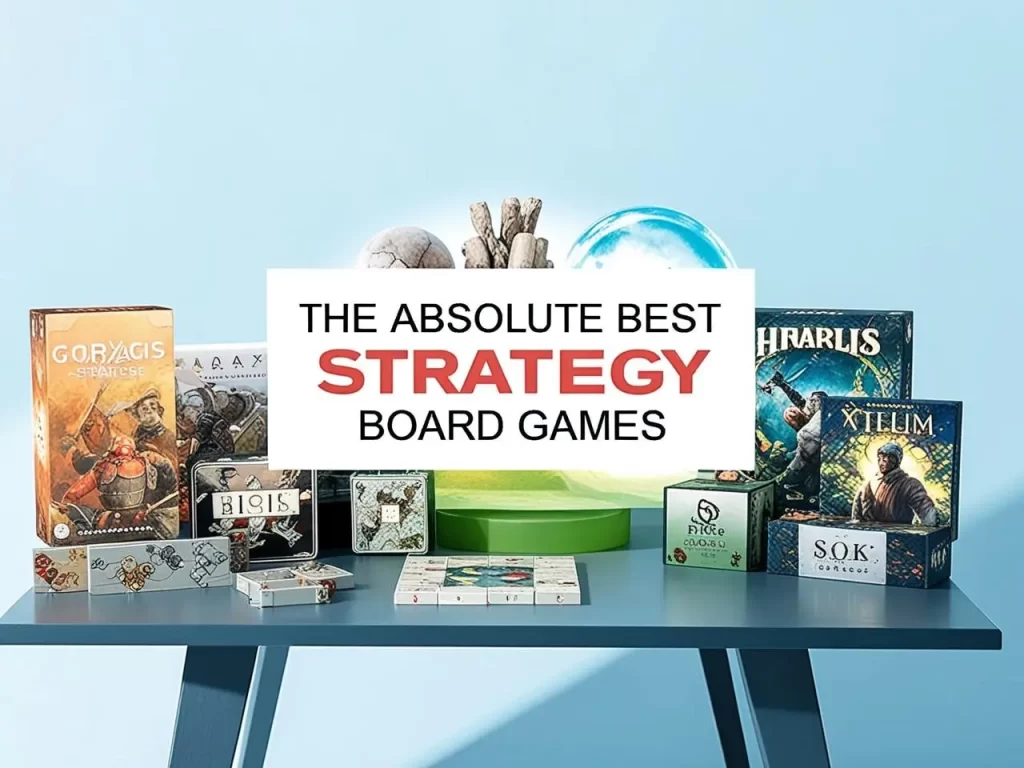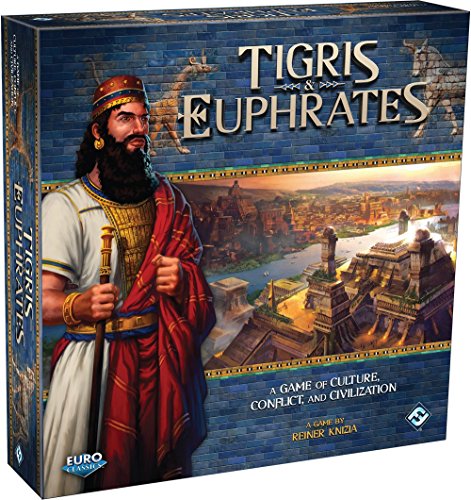Looking for the best games in strategy board games to bring to game night? Check out our well-researched list of the top 10 choices. Each game comes highly recommended by board game enthusiasts with a wide range of tastes and strategy types. You’ll find something for just about everyone right here.
What Makes a Great Strategy Game?
A great strategy game is one that challenges players to think critically and make informed decisions to achieve their goals. It should have a clear set of rules, a well-defined objective, and a variety of game mechanics that allow players to explore different strategies. A great strategy game should also be engaging, with a perfect balance of complexity and simplicity, providing a sense of accomplishment and satisfaction when played.
Some key elements that make a great strategy game include:
Clear Objectives: The game should have a clear and well-defined objective that players can work towards. This helps keep the game focused and gives players a sense of direction.
Varied Game Mechanics: The game should offer a variety of game mechanics that allow players to explore different strategies and approaches. This keeps the gameplay fresh and exciting.
Depth and Complexity: A great strategy game strikes a perfect balance between complexity and simplicity. It should have enough depth to keep players engaged but not so much that it becomes overwhelming.
Replayability: The game should be replayable, with multiple paths to victory and a high level of variability. This ensures that players can enjoy the game multiple times without it becoming repetitive.
Player Interaction: Whether through direct conflict, negotiation, or cooperation, player interaction is crucial. It adds a layer of unpredictability and excitement to the game.
By incorporating these elements, a strategy game can provide a rich and rewarding experience for players of all skill levels.
Types of Strategy Games
Strategy games come in many forms, each offering unique mechanics and gameplay experiences. Here are some common types of strategy games:
Abstract Strategy Games: These games focus on abstract concepts and mechanics, such as capturing pieces or controlling territory. Examples include classics like Chess and Go, where players must outthink their opponents to win.
Economic Strategy Games: These games revolve around managing resources and building economies. Games like Settlers of Catan and Puerto Rico challenge players to optimize their resource management and economic strategies.
War Strategy Games: These games focus on military conflict and conquest. Titles like Risk and Axis & Allies require players to deploy their armies strategically and outmaneuver their opponents.
Cooperative Strategy Games: In these games, players work together to achieve a common goal. Pandemic and Forbidden Island are great examples, where teamwork and coordination are key to success.
Competitive Strategy Games: These games involve players competing against each other to achieve a goal. Starcraft and Magic: The Gathering are popular examples, where players must outplay and outsmart their opponents.
Each type of strategy game offers its own unique challenges and rewards, catering to different tastes and preferences. Whether you enjoy the abstract thinking of Chess or the resource management of Settlers of Catan, there’s a strategy game out there for everyone.
Cooperative and Competitive Strategy Games
Cooperative and competitive strategy games offer distinct gameplay experiences, each with its own set of challenges and rewards.
Cooperative Strategy Games involve players working together to achieve a common goal. These games often require players to communicate and coordinate their actions to succeed. Examples of cooperative strategy games include:
Pandemic: Players work together to stop the spread of diseases across the globe. Each player takes on a specific role with unique abilities, and teamwork is essential to finding cures and preventing outbreaks.
Forbidden Island/Forbidden Desert: In these games, players must retrieve treasures from a sinking island or a desert before time runs out. Cooperation and strategic planning are crucial to success.
Hanabi: Players work together to create a beautiful fireworks display. The catch is that players can see each other’s cards but not their own, requiring careful communication and deduction.
Competitive Strategy Games, on the other hand, involve players competing against each other to achieve a goal. These games often require players to outmaneuver and outplay their opponents to succeed. Examples of competitive strategy games include:
Chess: A classic game where players compete to capture each other’s king. Strategic thinking and foresight are key to victory.
Risk: Players compete to conquer territories and eliminate other players. Strategic deployment of armies and alliances are crucial to success.
Starcraft: A real-time strategy game where players build armies and compete to destroy their opponents’ bases. Quick thinking and resource management are essential.
Both cooperative and competitive strategy games offer unique challenges and gameplay experiences, catering to different play styles and preferences. Whether you enjoy working together to achieve a common goal or outsmarting your opponents, there’s a strategy game for you.
The Ten Best Strategy Board Games
Imperium: The Contention

Age: 14+ (Community 12+) Players: 1-6 Time: 30-120 minutes
Containing over 300 cards for deck building, Imperium: The Contention gives players a distinctive strategy board game experience. Each player may choose one of six factions, which have their own preconstructed decks, or build their own unique deck from among the 300+ cards included in the game. Your goal: seize the Imperial Capital. But you could find yourself ruined if you manage it, so carefully choose your strategies to the top.
For new players, the first game often serves as a learning round, allowing them to become familiar with the mechanics and strategies before fully engaging in competitive play.
The game offers many pathways to ruling the Imperium, by gaining 8 favor or 8 world cards by the end. Ultimately, you must take the Void Scepter to win, by destroying enemy worlds, instigating political intrigue, and committing sabotage. You may employ spies, politicians, megacorps, or mercs to get there. Choose wisely or lose it all.
Terra Mystica
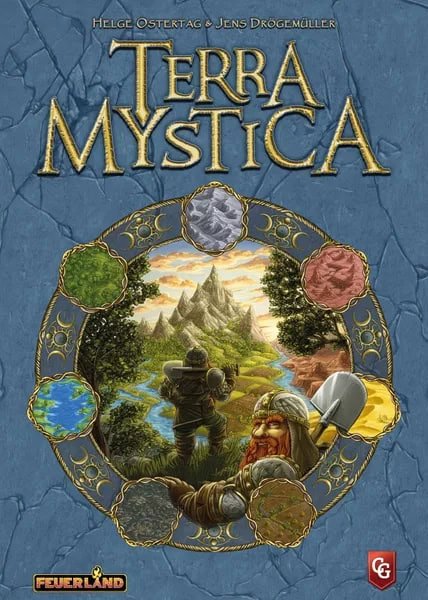
Age: 12+ Players: 2-5 Time: 60-150 minutes
14 people groups dwell in the land of Terra Mystica, across seven terrain types. Every people group has adapted to life within these terrains but they need access to other regions, and so must learn to terraform their neighboring landscapes to survive. Of course, each group is competing with others to make it on this land, and your goal as players is to help your chosen people group do it.
Each player governs one of the fourteen people groups, engaging strategies to help them understand new skills and adaptations required to survive a more well-rounded existence. You must employ subtlety and strategy to make it, though, as four religious cults aim to divide attention and claim people for their own.
In Terra Mystica, players compete to expand their networks and manage resources effectively, aiming to power the most cities.
During the game, players take turns executing actions on resources, such as developing more resources, employing workers, trading, increasing skills, and upgrading buildings. Each building type allows players to do specific actions, like temples allowing religious growth and strongholds unlocking your people group’s special skill set.
The terrains found in the game accommodate two people groups each:
Lake (Mermaids, Swarmlings)
Desert (Fakirs, Nomads)
Plains (Halflings, Cultists)
Wastelands (Giants, Chaos Magicians)
Forest (Witches, Auren)
Mountain (Dwarves, Engineers)
Swamp (Alchemists, Darklings)
Ultimately, achieving your goals as a people group before another player’s group means you win.
Azul
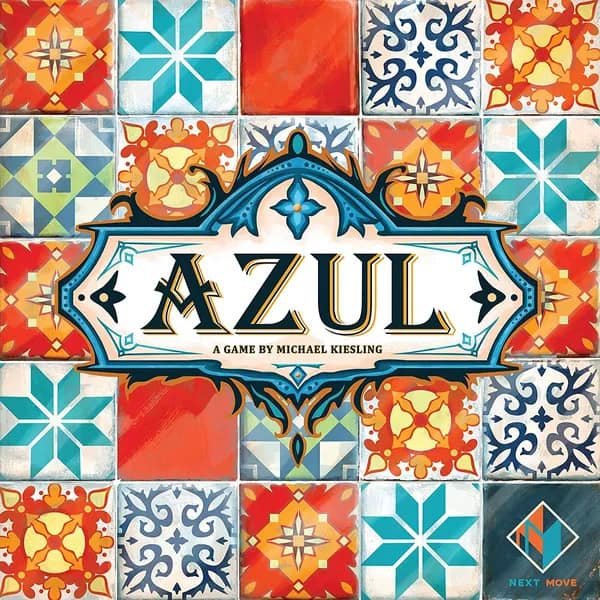
Age: 8+ Players: 2-4 Time: 30-45 minutes
The game Azul comes from the beautiful Moorish tiles purportedly loved so much by Portuguese King Manuel I on his visit to the Alhambra Palace in Southern Spain that he called for his palace to be redone in these blue and white tiles.
In this strategy board game, players become the tile artists, laying out the beautiful designs to embellish the Royal Palace of Evora. You’ll take turns drafting colorful tiles from suppliers and placing them on your player board. After the tile-laying is completed, players score their points based on the placements, with extra points earned for special patterns and completed sets. Wasted supplies harm your score, though, so be sure to manage your resources carefully!
While Azul does not involve a dice roll, the strategic decisions and resource management are crucial to winning. Whoever scores the most points by the end wins.
Tigris & Euphrates
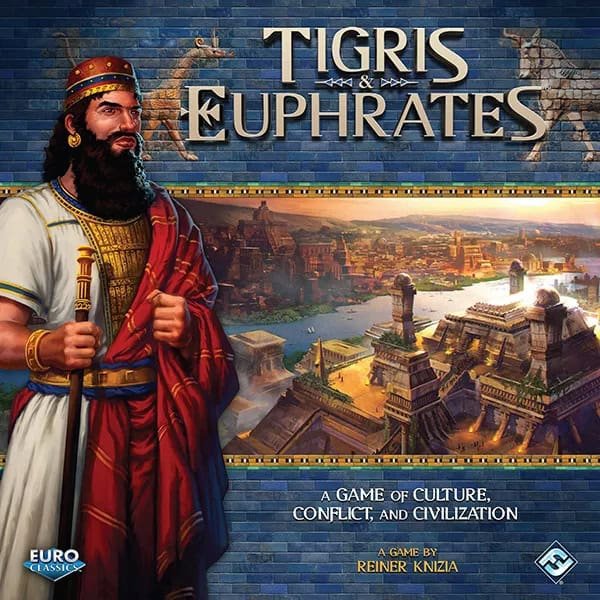
Age: 14+ (Community 12+) Players: 2-4 Time: 60-120 minutes
Set in the Ancient world of the Fertile Crescent (the Egyptian Empire), Tigris & Euphrates is a civilization-building game of tile placement. Players are each given four leaders: religion, government, trading, and farming. These leaders collect victory points in their own categories, but each player’s ending score is the number of points in their weakest area of development. That means you don’t want to overly specialize in any given area. Instead, develop a well-rounded society and avoid conflicts as your civilization connects with others growing around your region.
While not set during the industrial revolution, the game intricately mirrors the supply chain and production challenges characteristic of historical periods, emphasizing strategic interactions in resource management and economic competition.
The game includes a double-sided board, numerous components for both a base and advanced version of the gameplay, and the unique ziggurat expansion which crosses five spaces of the board. To build this, though, a player must have five civilization tokens of the same color and replace them with ziggurat markers.
Some versions of this game are listed as viable for 2-4 players, while others say 3-4. 2-4 is the accurate number, meaning you can play a duel or group game.
Kemet: Blood and Sand
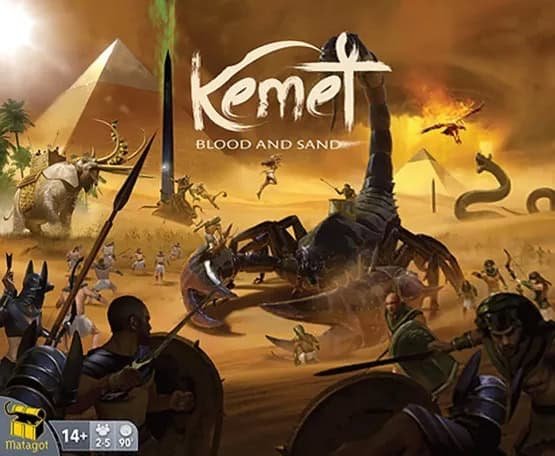
Age: 13+ (Community 10+) Players: 2-5 Time: 90-180 minutes
Also set in the Ancient Egyptian world, Kemet: Blood and Sand immerses players into the land of powerful gods who rule over both the desert and the Fertile Nile delta. The two- to five-player game is a strategy board game that engages with war tactics rather than civilization-building like most games set in the era. Players take on the roles of the Egyptian gods and pit their troops against each other in a vie for dominance.
Similar to the strategic conflicts of the Cold War, players must carefully plan their moves and anticipate their opponents’ strategies to gain the upper hand.
The game features stunning artwork, new mechanics updated from the older versions, and a more approachable rule set for folks looking for strategy without hours of learning the rulebook. You’ll also find unique map designs, large, detailed playing figures, and a variety of other unique touches that make the updated game a brilliant choice for any game night.
Root
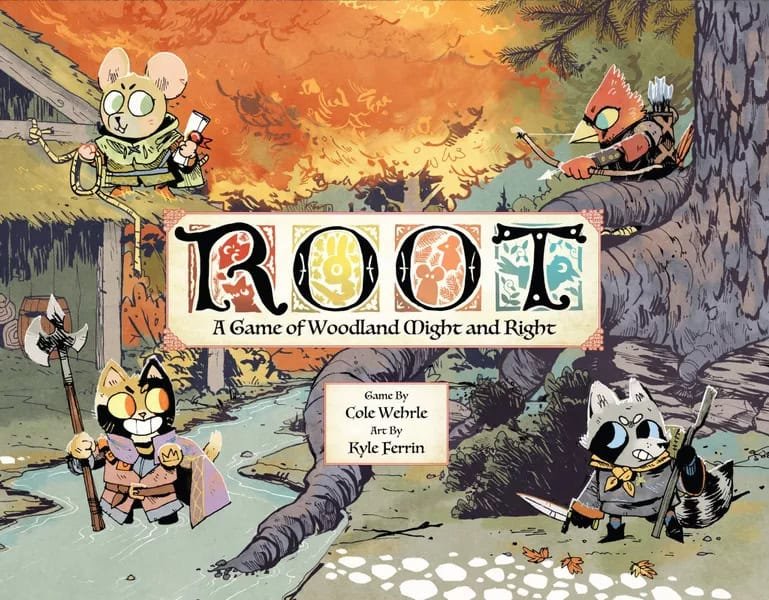
Age: 10+ (Community 12+) Players: 2-4 Time: 60-90 minutes
Players drive the narrative play of Root, a strategy board game for two to four players. The game usually runs about 60 to 90 minutes and works for players aged 10 and older. Players battle for control of the beautiful wilderness in which the characters live – with unique capabilities ascribed to each critter in play. The game has multi-use cards, with asymmetric mechanics, for accessible, intriguing play for all.
In Root, various factions are randomly paired with unique abilities and perks, enhancing gameplay diversity and replayability.
The premise of the game revolves around the evil Marquise de Cat, a would-be overlord in the woodland, who knows one thing: she wants all the riches. So the woodland critters must band together to fight this unrighteous ruler and gather resources and subvert the cat’s power. Players choose among characters to play: the Marquise de Cat, the Vagabond, the Woodland Alliance, or the Eyrie of Dynasties. Then, using wits and dice rolls, players use their best strategies and a bit of luck of the draw as they vie for control of the forest and its resources for survival and glory.
Dune
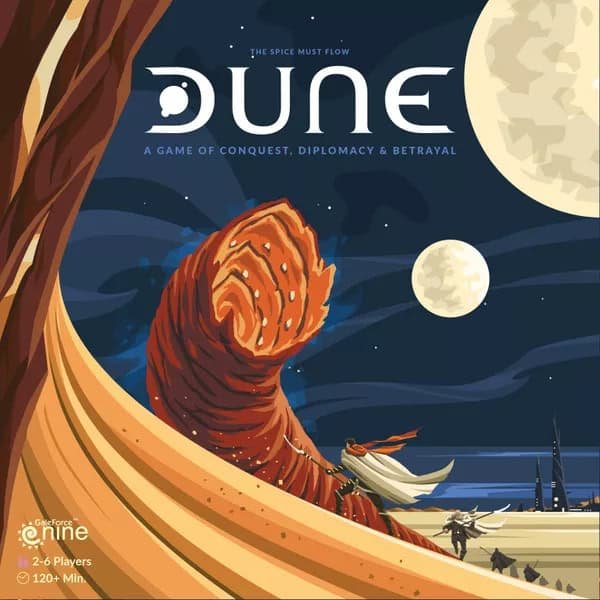
Age: 14+ Players: 2-6 Time: 120-180 minutes
Whether you’re a fan of the popular science-fiction novel and film franchise or not, the game of Dune makes for the perfect strategy board game for the older crowd. The two- to six-player game, designed for folks 14 and up, takes players through the strategic struggle for order and rule over the known universe. Players control the forces of the noble family, a religious order, or a guild, and lead their factions toward resource collection and, if all goes well, the win. Everyone wants to control the most valuable resource known to the world: melange, a mysterious spice of great rarity that enables space travel and great visions of the future.
Compete against each other over the two to three-hour playtime, and discover who will rule the world of Dune.
Archipelago
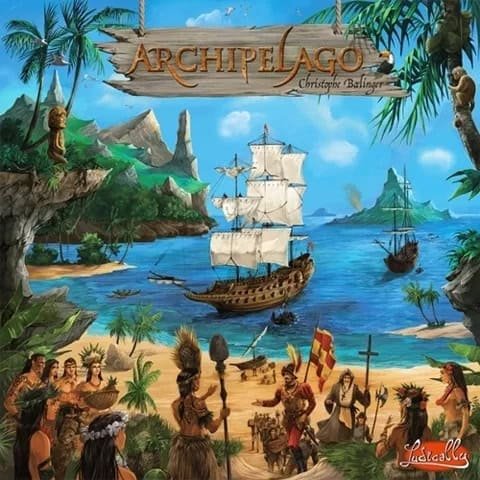
Age: 14+ Players: 2-5 Time: 30-240 minutes
Journey back to Renaissance Europe and the age of exploration when travelers sought their fortunes, new worlds, and the glories of the unknown world in Archipelago. The strategy board game pits players against each other in a race to build markets, harbors, cities, and temples, and develop trade with people across the planet. Each player engages with secret objectives, kept hidden until opponents guess their play and benefit from them.
As players explore and discover new territories, they’ve got to be careful: trade with other nations can get tricky, especially when the people aren’t so keen on your conquering ways. Carefully negotiate trade with the locals or everybody loses!
In addition to economic strategies, players must also engage in conservation projects to ensure their actions have a positive environmental impact, aligning with real-world efforts.
The game is intended to work like a “German” economic worker-placement strategy board game, minus the superficial theme and lack of player interaction. Instead find loads of backstabbing, hidden agendas, bluffing, and much more in the competitive game. Choose between three sets of objectives for short, medium, or long gameplay, or grab the expansion for a solo adventure.
March of the Ants
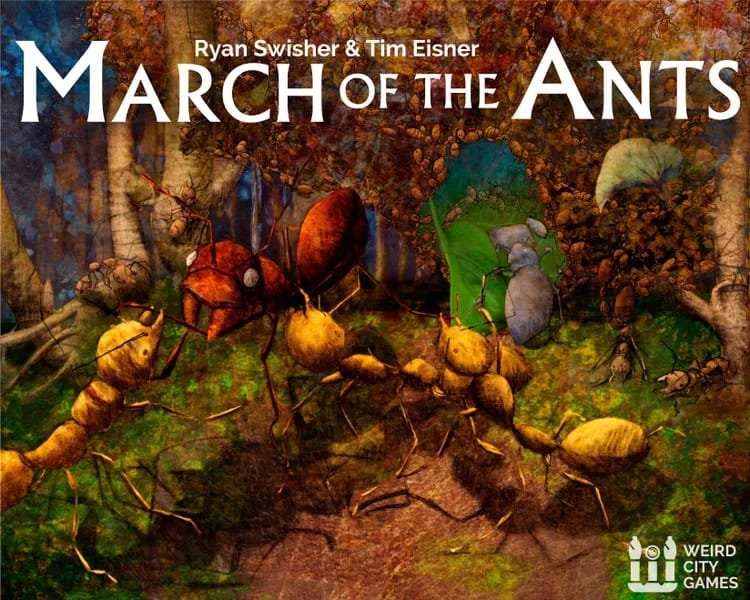
Age: 13+ (Community 12+) Players: 1-5 Time: 60-90 minutes
A new spring has thawed the world, and the March of the Ants has begun. They’re coming out of their underground world to find fresh food, build new nests, and enjoy their life as a colony above ground. In this unique strategy board game, players must share the world with other colonies while carefully planning their work above ground in the meadow. Send your soldier ants out to clear the path of centipedes and fight against other ants. Send your workers to dig your new, expanding network of tunnels for safe travel in the search for food. Watch as your larvae hatch, grow, and develop into a whole new generation as you aim to claim the meadow as your own terrain.
In March of the Ants, players act as expedition leaders exploring the meadow’s ancient history and uncovering its lost ruins.
On the game board, which represents the meadow, players must strategically send forth their ants to explore and discover supplies. Players must thoughtfully place and reveal two dozen unique tiles – Fern, Nest of Centipedes, Pebble, and others – to discover their routes. Along the way, you may find Event Cards like Cold Snap, Strange Appetite, or Fungal Outbreak, and act accordingly to save your colony. Or mutate your colony through Evolution Cards like Weaver thorax, Trap Jaw head, and Leaf Cutter abdomen to gain new powers. You could develop a new, fertile queen, mighty warrior ants, or highly skilled workers. Any of these could help you claim the victory. Ultimately, players must successfully complete Colony Goals to claim the victory and win the overall game.
A Game of Thrones: The Board Game
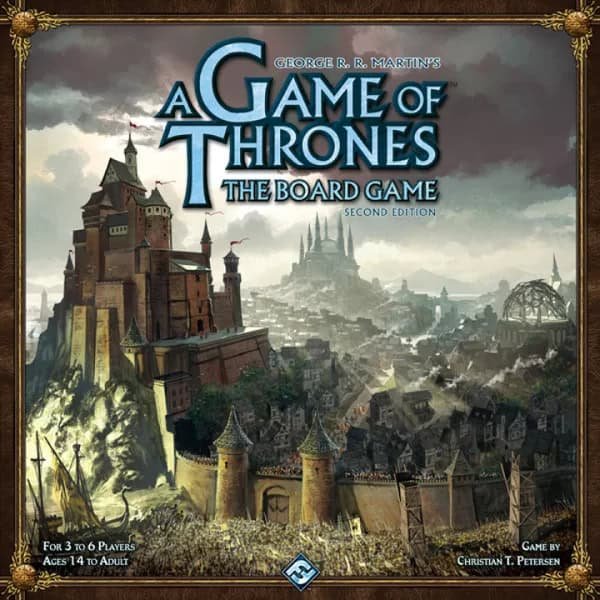
Age: 14+ Players: 3-6 Time: 120-240 minutes
Three to six players may enter the world of Westeros in A Game of Thrones: The Board Game to compete over 2 to 4 hours in a winner-take-all war game. In the game, each player takes on the role of one of the great Houses of the Seven Kingdoms of Westeros, seeking to control the Iron Throne. Use your strategies of warfare and diplomacy to wheel, deal, strike, and kill your way to victory before you’re stabbed in the back and pushed out into a cold, hard grave.
The variety and complexity of gameplay in A Game of Thrones: The Board Game is comparable to all the games available in the market, making it a standout choice for strategy enthusiasts.
A Game of Thrones: The Board Game is, of course, based on the popular book and television show franchise by George R.R. Martin.
To begin play, every player receives an army of knights, siege engines, ships, and footmen, along with order tokens and other components that enable them to plan and wage war. Every player also receives a deck of House cards, which represent leaders in battle as the Houses fight.
The game is made up of rounds, each of which goes through three phases: the Westeros phase, the Planning phase, and the Action phase. During the Westeros phase, special events and day-to-day activities occur, with actions controlled by the Westeros decks. In the Planning phase, players secretly assign orders to their units with their order tokens (face down) on each area under their control. In this phase, players must engage with their diplomacy and deduction skills. Then, finally, in the Action phase, the orders are enacted, with battles emerging. Players secretly choose which House cards to apply to their battles and gain or lose influence over the board accordingly. Ultimately, whoever takes over the Iron Throne wins the game.
Conclusion
Not all strategy games are alike and few share the same premise, at least in our list of the best strategy games. Of course, you’ll find plenty of war games like A Game of Thrones: The Board Game, March of the Ants, Kemet: Blood and Sand and Root, but unique strategies in Azul, Archipelago and others come out for a different take on the skill. So, choose your favorite themes and settings for a unique collection of strategically fun times.
FAQ on Strategy Board Games
1. What are some of the best strategy board games available?
Some of the best strategy board games include Imperium: The Contention, Terra Mystica, Azul, Tigris & Euphrates, Kemet: Blood and Sand, Root, Dune, Archipelago, March of the Ants, and A Game of Thrones: The Board Game. Each game offers unique gameplay mechanics and strategic challenges.
2. How does Imperium: The Contention stand out as a strategy board game?
Imperium: The Contention is distinguished by its deck-building mechanics, offering over 300 cards for players to create unique decks. Players can choose from six factions, each with specific abilities, and aim to seize the Imperial Capital through strategic moves involving spies, politicians, and more.
3. What makes Azul a unique strategy board game?
Azul is unique for its tile-laying mechanics inspired by Moorish tiles. Players act as tile artists, drafting colorful tiles to decorate the Royal Palace of Evora. Strategic placement earns points, while managing resources is crucial to avoid penalties from wasted supplies.
Can you explain the unique abilities in the gameplay of *Root*?
In Root, players battle for control of a wilderness, each taking on characters with unique abilities. The game features asymmetric mechanics and multi-use cards, allowing for strategic play as players vie for resources and power against the evil Marquise de Cat.
5. What is the setting and objective of A Game of Thrones: The Board Game?
A Game of Thrones: The Board Game immerses players in the world of Westeros, where they assume the role of a great House seeking to control the Iron Throne. Players use strategies of warfare and diplomacy to outmaneuver opponents over several rounds, with the ultimate goal of claiming the throne.

